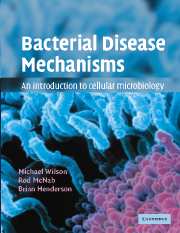Book contents
- Frontmatter
- Contents
- Preface
- Abbreviations used
- Chapter 1 An introduction to bacterial diseases
- Chapter 2 Bacterial cell biology
- Chapter 3 Molecular analysis of bacterial virulence mechanisms
- Chapter 4 Communication in infection
- Chapter 5 The mucosal surface: the front line of antibacterial defence
- Chapter 6 Immune defences against bacteria
- Chapter 7 Bacterial adhesion as a virulence mechanism
- Chapter 8 Bacterial invasion as a virulence mechanism
- Chapter 9 Bacterial exotoxins
- Chapter 10 Bacterial evasion of host defence mechanisms
- Chapter 11 Bacteria in human health and disease: the future?
- Appendix A Glossary of terms used
- Appendix B Brief descriptions of bacteria frequently mentioned
- Index
- Plate section
Chapter 2 - Bacterial cell biology
Published online by Cambridge University Press: 05 June 2012
- Frontmatter
- Contents
- Preface
- Abbreviations used
- Chapter 1 An introduction to bacterial diseases
- Chapter 2 Bacterial cell biology
- Chapter 3 Molecular analysis of bacterial virulence mechanisms
- Chapter 4 Communication in infection
- Chapter 5 The mucosal surface: the front line of antibacterial defence
- Chapter 6 Immune defences against bacteria
- Chapter 7 Bacterial adhesion as a virulence mechanism
- Chapter 8 Bacterial invasion as a virulence mechanism
- Chapter 9 Bacterial exotoxins
- Chapter 10 Bacterial evasion of host defence mechanisms
- Chapter 11 Bacteria in human health and disease: the future?
- Appendix A Glossary of terms used
- Appendix B Brief descriptions of bacteria frequently mentioned
- Index
- Plate section
Summary
Aims
The principle aims of this chapter are:
to provide a basic understanding of those aspects of bacterial structure and function that are particularly relevant to disease pathogenesis
to describe the various mechanisms used by bacteria to export virulence factors and other proteins
to provide an introduction to bacterial genetics, with emphasis on virulence mechanisms and the evolution of pathogens
to introduce the concept of bacterial biofilms
Introduction
In the succeeding chapters we will, time and time again, refer to the means by which bacteria damage their host, interfere with host cell functions and avoid the defence systems mounted by the host. All of these features of the lifestyle of a pathogenic bacterium are attributable either to the molecules of which the organism is composed (mainly those located on its surface) or to those molecules that it secretes into its environment. A knowledge of bacterial ultrastructure and the means by which bacteria export molecules is, therefore, central to understanding bacterial virulence mechanisms. However, this is only part of the story. New developments in molecular and genetic techniques are enabling us to make rapid strides in determining how bacteria have acquired those genes that encode virulence factors as well as how these genes are regulated. Such information not only contributes to our knowledge and understanding of these fascinating organisms but also could form the basis of new approaches to controlling bacterial diseases.
- Type
- Chapter
- Information
- Bacterial Disease MechanismsAn Introduction to Cellular Microbiology, pp. 46 - 110Publisher: Cambridge University PressPrint publication year: 2002
- 1
- Cited by

